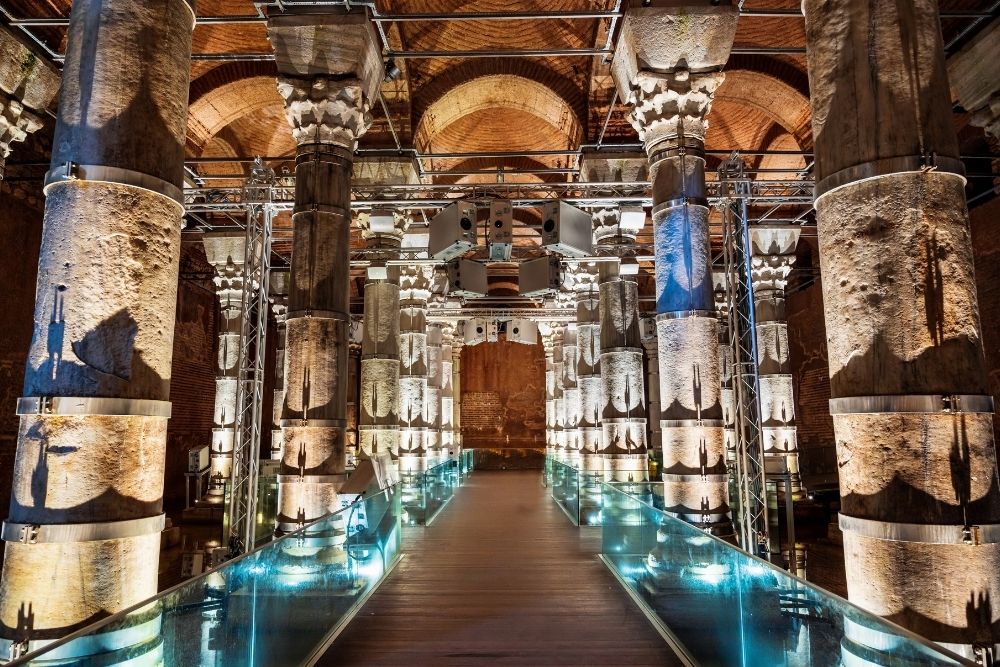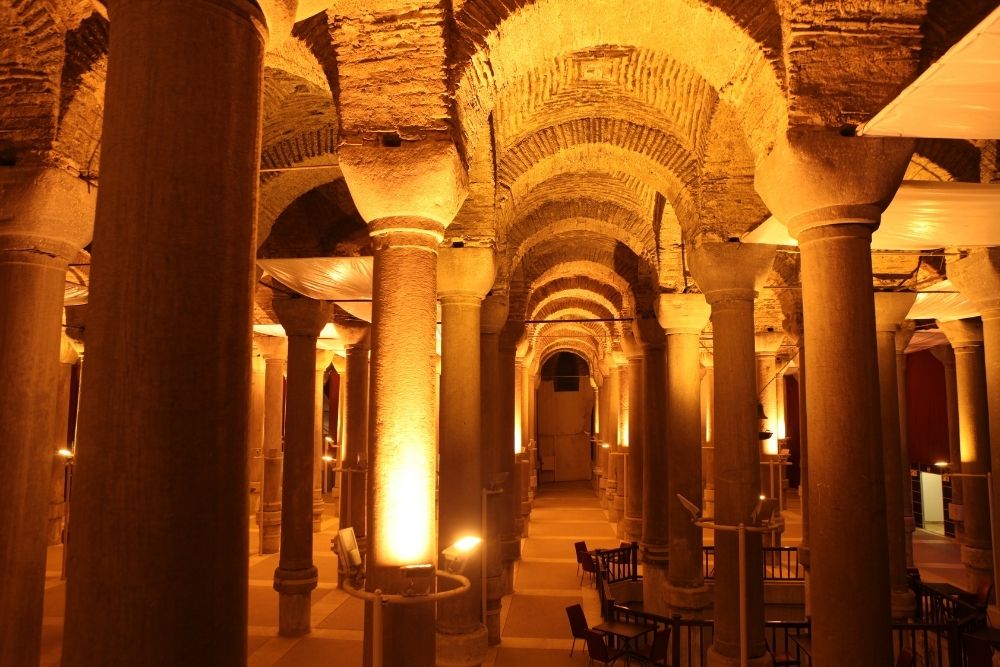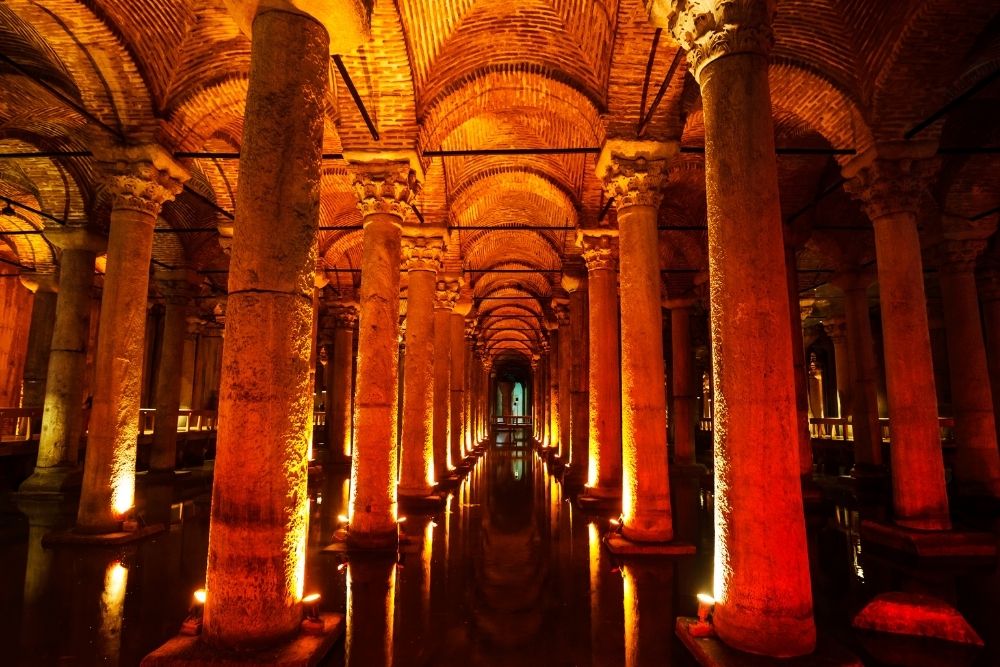Although Istanbul is a city known worldwide for its rich historical and cultural heritage, its underground monuments are as fascinating as its magnificent structures above ground.
The Basilica, Theodosius and Binbirdirek cisterns, quietly taking their place on the city's historical stage, stand out as rare structures from the Byzantine Empire that have survived to the present day. These mysterious cisterns are magnificent examples of Istanbul's ancient water storage systems and offer visitors a journey into the depths of history. Each with unique architectural features and historical significance, these three cisterns illuminate hidden worlds in the heart of the city and promise visitors unforgettable experiences. From the fascinating Medusa heads of the Basilica Cistern, to the restored corridors of the Theodosius Cistern and the "thousand and one pillars" of the Binbirdirek Cistern, this article takes a closer look at these impressive underground structures of Istanbul.
As well as being home to historic buildings, Istanbul is also known for its many impressive cisterns. The most famous of these is the Basilica Cistern, but there are many others waiting to be discovered:
Basilica Cistern Istanbul's Mysterious Underworld

Located in the heart of Istanbul, right next to Hagia Sophia, the Basilica Cistern is one of the city's most fascinating historical buildings. Built by the Byzantine Emperor Justinian I in the 6th century, this massive underground water reservoir has been restored many times throughout history and today serves as a museum open to visitors.
History and Architecture
The Basilica Cistern was built in 532 AD to meet the water needs of Istanbul. Spread over an area of about 9,800 square meters, the cistern is supported by 336 columns, and these columns carry the ceiling of the cistern. Most of the columns are taken from old structures brought from different places, which gives Yerebatan a unique atmosphere.
Medusa Heads
One of the most interesting parts of the cistern is the two Medusa heads. These heads are placed upside down or sideways at the base of the columns at the very back of the cistern. There are many theories as to why the Medusa heads were positioned in this way, but the most popular theory is that they were used to keep evil spirits away.
A Journey Under Water
As visitors walk through the cistern's cool and lightly lit corridors, they can see large fish swimming on the water and feel the mysterious atmosphere of history. The Basilica Cistern offers a mesmerizing ambiance, especially with the lighting and reflections created by the water.
Cultural Events and Concerts
The Basilica Cistern is not only a historical building, but also hosts many cultural events. Throughout the year, various concerts, exhibitions and special screenings take place within the walls of this historic venue, offering visitors unforgettable experiences.
Theodosius Cistern The Hidden History of Istanbul

Theodosius Cistern (Şerefiye Cistern) is a hidden treasure in the Sultanahmet district of Istanbul's historic peninsula. Built in the 5th century during the reign of Byzantine Emperor Theodosius II, this impressive structure is one of the oldest and most important water storage facilities in the city. The cistern, which opened its doors to visitors with the restorations made in recent years, attracts attention with its fascinating atmosphere and historical importance.
History and Architecture
Theodosius Cistern is a gigantic structure built to meet the water needs of Byzantine Istanbul. The cistern is about 40 meters long and 25 meters wide and is supported by 32 columns. The columns are usually made of sandstone and marble and decorated with classical Byzantine capitals. The ceiling of the structure is supported by arches, showing an excellent example of engineering.
The World Under Water
The cistern transports visitors to another time with its enormous dimensions and dark, cool atmosphere. The water surface, together with the reflected light, further enhances the mystical atmosphere of the cistern. Walking inside the Theodosius Cistern, you witness how history is preserved in silence.
Restoration and Cultural Heritage
In recent years, the Theodosius Cistern has been restored to its former splendor and opened to visitors. The cistern also hosts various artistic events and concerts from time to time, transforming it from a mere historical site into a cultural center.
Binbirdirek Cistern Istanbul's Hidden Beauty Under History

The Binbirdirek Cistern is one of the most impressive historical buildings in Istanbul, shedding light on the city's rich past. Built in the 6th century by the Byzantine Emperor Justinian I, this massive underground water reservoir is famous for its "thousand and one pillars" and serves as a historical site open to visitors in the Sultanahmet district.
History and Architecture
Binbirdirek Cistern was built on 224 marble columns. These columns resemble the thousand and one pillars that gave the structure its name. The cistern is spread over an area of approximately 3640 square meters and exhibits an outstanding example of ancient engineering and architecture. The symmetrical arrangement between the columns and the arches not only makes the cistern aesthetically impressive, but also ensures its structural integrity.
Life Under Water
While walking through the cistern, the play of light reflected on the water offers visitors a peaceful and mystical atmosphere. The water was once used to meet the city's water needs, and today the cistern is considered a unique discovery area for history lovers.
Cultural Events and Utilization
Binbirdirek Cistern has undergone various restorations over time and has hosted different cultural events. Concerts and art shows, especially in the summer months, revitalize this historical place and give visitors unforgettable moments.


